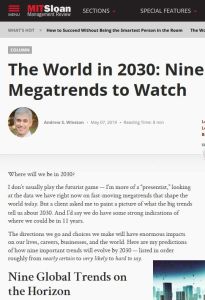
Andrew S. Winston
The World in 2030
Nine Megatrends to Watch
MIT Sloan Management Review, 2019
What's inside?
Nine current trends will come to define the world in 2030.
Recommendation
Predicting the future remains a tricky business. Yet without an idea of how the world will look like 10 years down the road, business leaders will be hard-pressed to come up with a sensible strategy. Business adviser Andrew Winston has identified nine current trends he believes will shape the world by 2030. Writing for MIT Sloan Management Review, he explains how businesses can accommodate these trends. Although the future will never happen exactly as expected, Winston’s pragmatic roadmap will be useful for strategists and business leaders alike.
Take-Aways
- Nine global trends will decisively shape the world by 2030.
- Businesses must – and most likely will – take on a much more proactive role in shaping the world of the future.
Summary
Nine global trends will decisively shape the world by 2030.
A number of global trends are already in full swing today and will likely dominate the world in 2030:
- “Demographics” – The world population will rise to an estimated 8.5 billion people, with the largest increase among the elderly. Most of the one billion people who will be more than 65 years of age will be part of the economic middle class.
- “Urbanization” – Two-thirds of the world population will be living in cities. To accommodate the rising number of city-dwellers, urban planners will need to deploy big data and AI to improve building efficiency and ensure food supply.
- “Transparency” – Personal privacy will continue to erode as data collection grows along with improved technology to analyze the data. The upside for consumers is that they will be able to make better-informed product choices based on what’s important to them – whether it’s a low carbon footprint or socially responsible manufacturing.
- “Climate crisis” – Average global temperatures will have reached the 1.5°C [2.7°F] mark within the next 10 years. Rising sea levels will make many coastal areas uninhabitable and create millions of environmental refugees. Major agricultural areas will no longer be arable due to prolonged droughts. Many animal species and entire ecosystems will be on the verge of extinction. And the Arctic will be passable for shipping during the summer months.
- “Resource pressures” – Resource scarcity will become a major theme. Humans will need to find ways to recycle metals and other finite commodities from existing products. Also, they will need to find ways to combat growing water shortages – for example, through desalination or improved water technology.
- “Clean tech” – Clean technology is already on the rise, and the price for renewable energy will continue to drop. By 2030, electric vehicles will likely dominate the road. Data-driven technology will also help make buildings, power supplies and water systems much more efficient.
- “Technology shifts” – AI and machine learning will dominate human lives by 2030. All new devices will be connected to the Internet of Things, which will help humans optimize virtually everything they do in their daily lives, as well as take over many of their current jobs.
- “Global policy” – It is unclear whether the international community will be more or less inclined to work together to tackle the world’s major problems, especially climate change. The private sector will likely be playing an increased role in promoting sustainability.
- “Populism” – While populism is on the rise in many countries around the world, popular resentment against autocracy is also growing. It’s unclear which side will win.
Businesses must – and most likely will – take on a much more proactive role in shaping the world of the future.
Climate change will wreak havoc on the global economy. Hence, combating climate change’s worst effects will make business sense for private corporations. Tools they have at their disposal include engaging employees, consumers and customers in the climate discussion; making climate-friendly investments; and using their influence over policy makers to nudge them toward endorsing policies such as carbon taxation. As AI technology is rapidly disrupting the workplace, businesses must help their employees redefine their purpose and place within the company and within the larger community. Furthermore, companies won’t be able to hide from growing public demands for increased transparency about their supply chains and business relationships, so it’s best to play with open cards as much as possible.
“Each successive generation will expect more openness from the companies they buy from and work for.”
Finally, companies will have to accommodate the priorities and values of the younger generations – the millennials and gen Z – who will dominate the world of work by 2030.
About the Author
Andrew Winston is founder of Winston Eco-Strategies and an adviser to multinationals on how they can navigate humanity’s biggest challenges and profit from solving them.
This document is restricted to personal use only.
My Highlights
Did you like this summary?
Read the articleThis summary has been shared with you by getAbstract.
We find, rate and summarize relevant knowledge to help people make better decisions in business and in their private lives.
Already a customer? Log in here.

















Comment on this summary